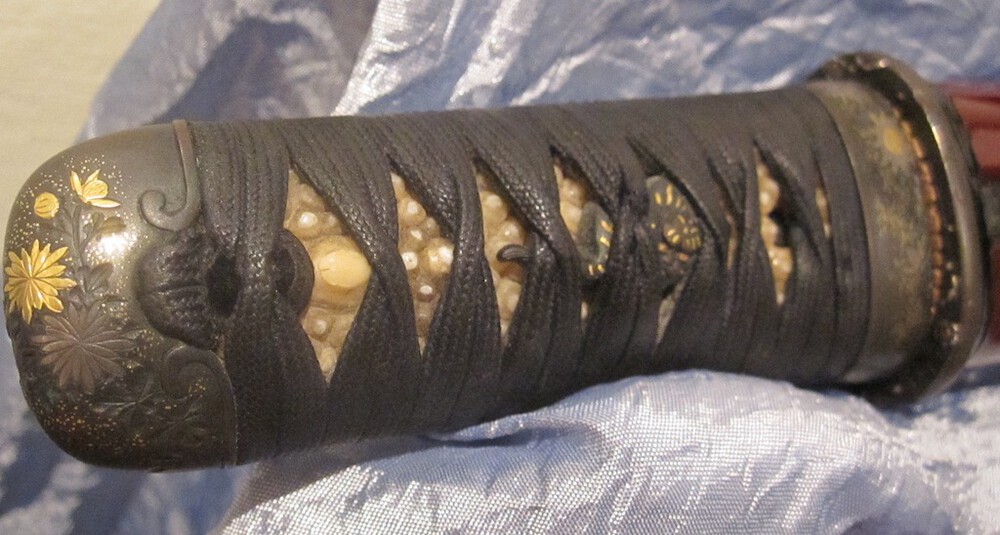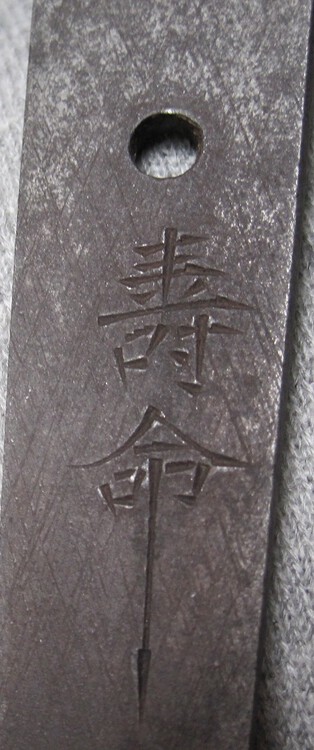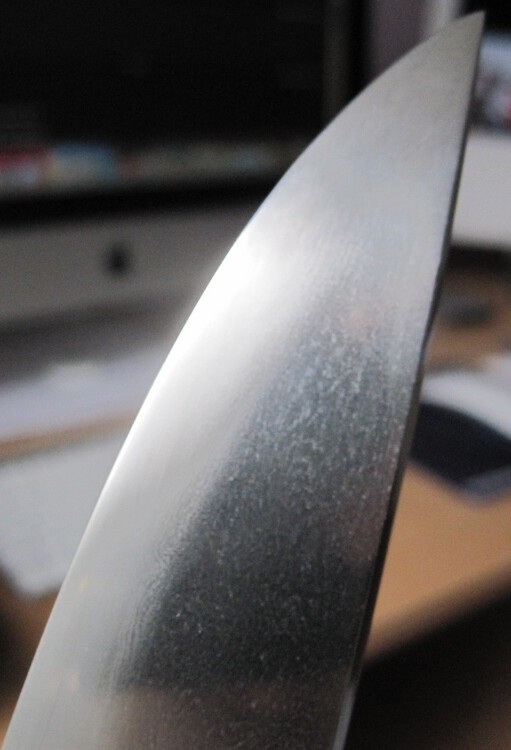-
Posts
534 -
Joined
-
Last visited
-
Days Won
2
Content Type
Profiles
Forums
Events
Store
Downloads
Gallery
Everything posted by Viper6924
-
Chris; I read the same description for funbari, except the word "man" was changed to "Sumowrestler". Probably just to give the importance of funbari some more weight :lol: So I guess this blade falls under the "funbari" classification? Or..... /Jan
-
Thanks again, Jacques for taking the time to help me. Highly appreciated! /Jan
-
Hi Jacques! Thats really intresting. I don´t suppose You have picture or some other info about this tachi? I´m trying to get me head around my own old Bishu Osafune "tachi-looking" sword with a katana mei. Driving me crazy I thought that the change from wearing tachi to katana started around 1380-1400. This Nagamitsu blade is almost 100 years earlier. Well, you learning something new every day. Thanks again, Jacques! /Jan
-
Thanks again, Veli. /Jan
-
Another question on this subject: When did the the smiths start using the "Bishu Osafune"-kanji combination? The "Bizen Osafune" goes way back. /Jan
-
As always, Jean and Veli! On both threads :D THANKS!!! /Jan
-
Hi guys! I´m sitting and study little dif kanjis. One question pops up: In the book "The samurai sword handbook" by Yumoto there is a section with kanjis. There are four dif kanjis for Bishu. Which he calls Bi provinces; Bizen, Bitchu and Bingo. Whats the dif between Bishu and Bizen when You write it in kanji? Whats the kanji for: "Bizen Osafune" compared the "Bishu Osafune"? Thanks! /Jan
-
Curran, the tsuba is not part of the orginal koshirae. There is only a inlet for a kozuka nothing for a kogai/umbari. This will be a future project to find a nice tanto-tsuba that compliment the rest of the koshirae. John.L, I also agree with You about the shinsa in this case. I think it has a above average chance to pass. Ford Hallam, The workmanship and artistry should take president over signatures, especially in cases with few examples to compare with. And as You say, in this case the mei look fluid and original. Well, I guess I should pack my bag with a few blades and koshiraes and start looking for the nearest shinsa... Thanks for all the input! Jan
-
I will not argue against You, Pete. Like I said, I have seen a lot of so called Funada Ikkin the 1:st mei to know this is a minefield. This mei are amongst the better looking ones. Plus that the workmanship is really good. I think this mei is pretty close to the left one in your att. But, I´m in no position to huff and puff to much. More input on this mei would be helpful. Thanks again Pete and Nagamaki! Jan
-
Thanks John and Curran for Your comments. Looking at the fine details I also think it´s the first or second generation Ikkin. I of course hope it´s no 1. I´ve seen a bunch of different mei from this artist, so I really need more help with that. Here´s two more pictures. It´s really hard taking good pics. Thanks again! Jan
-
Hi! I have a nice koshirae for a tanto. Fuchi is signed Funada Ikkin. Very nice mei, but which generation do You think it is? The details are very fine indeed. All input is appreciated! /Jan
-
A big THANKS on the info, Jean! You are the man regarding Bizen... and probably more. I include the mei so You can doublecheck Louis, here´s the pics. Hope You like. Thanks again, Jean! Jan
-
Louis; I will post a pic when I come home. Look out Jean; You are right. In this case, the Japanese I bought the yari from told me the first word was "Kawati" which I´ve not been able to find anywhere. When I saw the word kawachi, I just jumped on it. I still find it a bit strange. The mei reads "Kawachi no kami sukesade bizen koku osafune ju". Whats does it really mean? Kawachi, Bizen and Osafune are all geographic names. A bit confusing Have mercy, Jean /Jan
-
As always Jacques, THANK YOU! Jan
-
Hi Guys! What does this "Kawachi" means? I haven´t been able to find a good translation. I have a jumonji yari with the mei "Kawati (Kawachi) no kami sukesade bizen koku osafune ju". I think the seal is very intresting. Never seen anything like this before. /Jan
-
Thanks Jean! I can def see some similar activity in this hada compared to my tanto. Mmm, I wouldn´t want to work as a shinsa-judge... Thanks again, Jean! Jan
-
Hijiki-hada = A type of ō-mokume-hada or ō-itame-hada with thick chikei. Sounds intresting, Jacques. Anyone´s got a picture of this hada? /Jan
-
Yes Adam, thats the page. There are serveral others with more info to. But no one thats very helpful in this case. Ted, I´m happy you seems to agree with me on the hada These Jumyu-smith seems to have mixed it up over the years. I have seen a bunch Jumyu-blades on the internet. Katanas, wakis and tantos and no one comes close at having this kind of hada. I have learned one thing since joining this forum; Doesn´t matter if we talking about old katanas with orikaeshi-mei, sunnobi-tantos/waki or Jumyu-tantos with wild hada thats looks like big old pine trees from northern quebec the road for knowledge regarding nihontos is both long and hard. Best not travelled alone... And thats the nihonto-poetry for the day!!! /Jan
-
Louis, You must have beautiful forrests up in Quebec Chris, Yeah, when I saw this tanto for the first time I was really taken by the hada. Even I could place it in late shinto to shin-shinto period. So I started to look around for unusual hadas. I found the Rekko hada in a book. Couldn´t really find anything that made a better match. Now when I see this matsukawa hada, I think it´s a bit closer. But not 100%. The koshirae is really nice. So someone have put some money into it. I only wish the mei could help a little more. /Jan
-
So we can conclude this blade has a little bit of everything. Thats what I call an active hada Thanks Brian! Jan
-
Hi Chris! So I guess finding out which Jumyo will be pretty hard. Another shinsa-projekt for the future Anyway, by looking at the overall blade and the hada, it must have been a fairly skilled smith. Thanks again, Chris! Jan
-
Thanks Jacques and David. I thought "JUMYO" only was a mei the smith wrote on blades that were being given away as gifts to persons or temples. So this is acctually the name. Mmm, intresting. Thanks again, guys! Jan
-
Hi Paul! I agree with the "element of subjectivity". For a rookie like myself, who starts to take nihonto really serious, it´s great to hear the great minds of this board. Nihonto is like any other artform. There is no 100%. I also understands it´s very hard to cast good judgements based on badly taken pictures. But many members on this board are highly skillful. So it´s always worth a try. And even if I get 5-6 dif suggestions for a maker, it´s somewhere for me to start digging deeper. And if anyone heard of a future shinsa in the north of Europe, give me a shout :D All the best! Jan
-
First I must thank You all for an highly intresting conversation I´m soaking everything up like water. Second I feel this is another shinsa-projekt. I include some more pictures (it´s hard to take good pictures of the hada). One picture of the overall shape and one of the "long life" mei. Any idee´of the maker? P.S I really like the picture 0725. Looks like a an almost perfect set of evil looking eyes Thanks again! Jan
-
:D Ok, you asked for it: Perhaps Mokume mixed with Itame. The reason I ask is because I not seen this "wild mix" in any of my other swords. And then I saw a jihada called Yakumo-hada, which I think also could be a correct answer. The sword is a shin-shinto. But perhaps I´m barking up the wrong tree. Now let me have it... /Jan



















